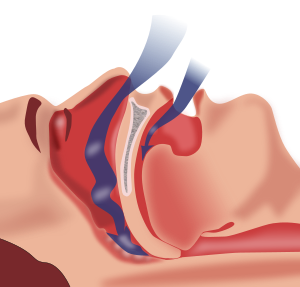A serious condition called Snoring
April 24, 2018 | Tuesday | Features | By Dr Dillon Dsouza
Sleep apnoea may be obstructive, central or a combination called complex sleep apnoea.
Image credit- wikipedia.org
Snoring is a condition where something in the nose, mouth, throat or lungs blocks breathing while sleeping producing a soft or loud and unpleasant sound. It is a sign or first alarm of OSA (obstructive sleep apnoea).
Sleep Apnoea is where there are one or more pauses in breathing while you sleep. Pauses may last a few seconds to minutes, and as many as 30 times an hour. Breathing usually restarts with a loud snort or choking sound. Sleep apnoea may be obstructive, central or a combination called complex sleep apnoea.
Causes-
Snoring and Obstructive sleep apnoea- In the nose a crooked nose bone or polyps are common causes, in the throat, throat muscle weakness, loose or tight jaw, fat in the neck, thick tongue, loose low roof of mouth, or tongue falling back while sleeping on the back. Relaxants like alcohol or some medicines also cause this.
Effects-
- Medical- Increased risk of high blood pressure, heart attack, stroke, obesity, diabetes, heart failure, irregular heartbeats, and driving or work related accidents.
- Psychosocial- irritability, poor concentration.
- Social- Usually bed partner is also tired, irritable and suffers sleep deprivation due to the loud snoring . At one time sleep apnoea and snoring was a major cause for divorces or separations around the world .
Signs and symptoms-
- In adults include loud chronic snoring almost every night , choking snorting or gasping during sleep, pauses in breathing, waking up often feeling out of breath, daytime sleepiness and tiredness, waking up with a dry mouth, going to bathroom often at night, forgetfulness and decreased concentration, morning headaches, impotence in men.
- In children loud snoring, sleeping in strange positions, bedwetting , heavy sweating at night, or night termors are frequent symptoms.
Risk factors- overweight, male, over 50, smoker, high blood pressure, alcoholic, or thick neck collar size over 40 cm. Crooked nose bones, large tonsils, flat chin, allergies and nasal polyps.
Treatment-
Medical- all treatments for snoring and sleep apnoea try to fix the blockage or bypass it. These include special pillows, devices to keep the jaw aligned or the nose open, machines that continuously blow air into the nose and throat to keep them open (CPAP). These are all for mild to moderate cases.
Surgical- Uvulopalatopharyngoplasty (removal of tissues in back of throat), surgery to correct crooked nose bones and remove extra tissues from the nose, removal of tonsils , reducing the size of the tongue, and insertion of stiff materials into the top of the mouth . Hyoid advancement where the bone in the neck to which tongue is attached is pulled up and forward, tongue advancement by moving the tip of the jaw outward, lower jaw advancement, where the entire upper and lower jaw is moved forward by 1.2 cm, and making a hole in the neck called a permanent tracheostomy (for extreme cases).
Self help tips-
Loose weight, exercise or brisk walking, lifestyle changes, mouthpieces and use of breathing devices. Also, identification of other conditions causing obstruction like allergies and avoiding anything that causes allergies and blocked nose. Quitting drinking, smoking and avoid taking sleeping pills or sedatives of any kind. Avoid caffeine and heavy meals two hours before sleeping. Yoga to strengthen the muscles of the throat. Maintain regular sleeping hours. Sleeping on the side (or ask bed partner to roll you over if you snore), wedge a pillow stuffed with tennis back behind the back to prevent rolling onto the back, elevate the head of the bed by 4 to 6 inches.
If the cause of sleep apnoea is heart or nerve problems or any kind of brain damage or diabetes, get it treated by a specialist.
Get a sleep apnoea test called a polysomnography done.
Learning to play blowing instruments and singing can also strengthen throat muscles and reduce sleep apnoea.
Home exercise for sleep apnoea include-
- Press the tongue down and brush top and sides of tongue with toothbrush.
- Press the tongue up against the roof of mouth and hold it there for 3 minutes a day.
- Purse the lips as if going to kiss and move them up and to the right, then up and to the left 10 times. Repeat again 3 times.
- Blow a balloon by breathing in through nose and out through mouth 5 times .
- Gargle with water five minutes, twice a day.
- Lightly hold the tongue in teeth and swallow five times. Repeat this 5 to 10 times a day.
- Dr Dillon Dsouza , Mumbai based Consultant ENT and Head and Neck surgeon, Snoring and Sleep Apnoea, attached to Jaslok Hospital and Desa Hospital










